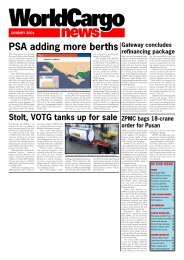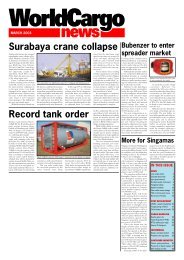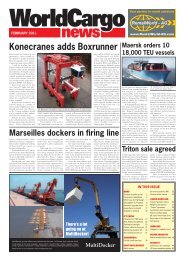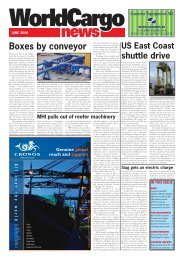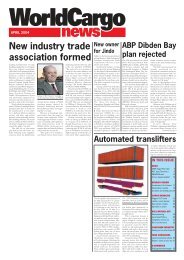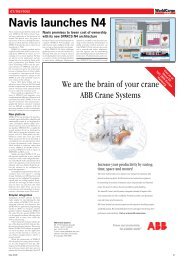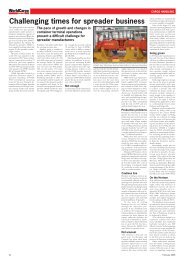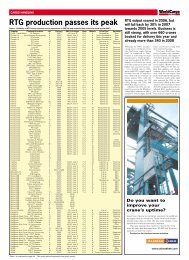US-built box crane - WorldCargo News Online
US-built box crane - WorldCargo News Online
US-built box crane - WorldCargo News Online
Create successful ePaper yourself
Turn your PDF publications into a flip-book with our unique Google optimized e-Paper software.
CONTAINER IND<strong>US</strong>TRY NEWS<br />
Savi launches SaviTrak...<br />
Savi Networks LLC, the Savi Technology/Hutchison<br />
Port Holdings<br />
joint venture set up earlier this year<br />
to build and operate a global<br />
RFID-based information network<br />
to track and manage containerised<br />
cargo (see <strong>WorldCargo</strong> <strong>News</strong> April<br />
2005, p1), has announced the operational<br />
launch of its SaviTrak information<br />
network with the first<br />
commercial shipments of consumer<br />
products from a factory in China<br />
to a distribution centre in Southern<br />
California.<br />
Savi Networks and Mitsui &<br />
Co (<strong>US</strong>A) are providing real-time<br />
information and logistics services<br />
within the network to a large Japan-based<br />
supplier of consumer<br />
goods to major <strong>US</strong> retailers, including<br />
Wal-Mart.<br />
The shipments, which were on<br />
the water at the time of writing,<br />
are aimed at proving the commercial<br />
benefits the information network<br />
can bring to major consumer<br />
goods suppliers in meeting<br />
and exceeding Radio Frequency<br />
Identification (RFID) compliance<br />
mandates while improving security,<br />
logistics data accuracy, visibility,<br />
and the operating metrics of<br />
containers and their contents. The<br />
information services are provided<br />
on a per-container trip basis.<br />
An innovative aspect of the<br />
project is “source tagging” of cases<br />
with EPC-compliant passive labels<br />
at the manufacturing facility, as<br />
well as tagging of the containers<br />
in which the cases are shipped<br />
with active RFID tags, offering socalled<br />
“Nested Visibility,” which<br />
enables the customer to automatically<br />
build the container manifest<br />
and then automatically track the<br />
container and its contents along<br />
its end-to-end journey throughout<br />
the shared network.<br />
“This initial trade lane project<br />
marks the operational readiness of<br />
the network and SaviTrak and<br />
demonstrates how managed services<br />
that leverage information<br />
from passive and active RFID<br />
technologies help international<br />
suppliers meet the business challenges<br />
of retail RFID mandates,<br />
transportation security concerns,<br />
as well as the pressures for better<br />
The Savi Tag ST-676 ISO Container Security Tag clamps onto the container<br />
door and communicates wirelessly via radio waves to the network on the container’s<br />
identity, contents, location, security status and interior conditions, such as light,<br />
temperature and humidity<br />
operational efficiency and customer<br />
service,” said Lani Fritts,<br />
COO of Savi Networks. “We are<br />
delivering managed information<br />
services to shippers that enable<br />
innovative buying, planning and<br />
transportation decisions through<br />
our real-time network.”<br />
The SaviTrak programme uses<br />
several types of active RFID tags,<br />
including Savi Technology’s latest<br />
advanced Savi Tag ST-676 ISO<br />
Container Security Tag, which<br />
clamps onto the container door<br />
and communicates the container’s<br />
identification, contents, location,<br />
security status and interior environmental<br />
conditions to the network,<br />
and the EJ Brookes E-seal,<br />
both of which are based on ISO<br />
18000-7 standards that operate on<br />
the 433.92 MHz radio frequency.<br />
Conformity with this international<br />
standard enables both products<br />
to interoperate within an<br />
ISO-based information network<br />
with support from countries<br />
worldwide for intermodal supply<br />
chain usage.<br />
ST-676 is a new generation<br />
Savi security tag that uses a door<br />
sensor and light sensor to detect<br />
security breaches as well as other<br />
sensors for temperature, humidity<br />
and shock to capture information<br />
on the environmental conditions<br />
inside the container.<br />
The EJ Brooks E-Seal, tested<br />
alongside the ST-676, is a singleuse,<br />
RFID-enabled electronic bolt<br />
seal for intermodal containers.<br />
Both are expected to be commercially<br />
available in November.<br />
● Aimed at the storage and transport<br />
of nuclear, bio-chemical and<br />
other hazardous materials, EJ<br />
Brooks has launched the Fiber<br />
Lock, a tamper-indicative sealing<br />
system comprising a specially-designed<br />
imaging verifier and a seal<br />
bundle constructed of randomlypositioned,<br />
acrylic optical fibres.<br />
Once the seal has been correctly<br />
applied to a sensitive security application,<br />
the seal body is inserted<br />
into a slot in the verifier’s housing<br />
and a digital image of the severed<br />
ends of the fibre optic bundle<br />
is recorded. The digital image<br />
can then be electronically forwarded<br />
to the shipment’s destination.<br />
At any point in transit, the<br />
seal can be visually inspected for<br />
any sign of tampering by shining<br />
a flashlight at one end of the fibre<br />
bundle. If the remaining bundle is<br />
brightly illuminated, it is an indication<br />
that the seal is intact.At final<br />
destination, the bundle can be<br />
reverified by comparing the digital<br />
image with the electronicallyfowarded<br />
image taken at the point<br />
of origin. If the images are identical,<br />
it signifies that the seal has not<br />
been compromised and no unauthorised<br />
access has occurred. Any<br />
differences serve as evidence of<br />
tampering.<br />
<strong>WorldCargo</strong><br />
news<br />
...IBM/Maersk offer <strong>box</strong><br />
tracking alternative<br />
IBM and Maersk Logistics, part of<br />
the AP Moller-Maersk Group, have<br />
launched an alternative to SaviTrak<br />
in the shape of Intelligent Trade<br />
Lane, which is touted as a new initiative<br />
to bring enhanced, real-time<br />
visibility to global supply chain operations<br />
by improving the quality<br />
of container tracking and enabling<br />
increased security of transported<br />
goods.<br />
The IBM/Maersk solution incorporates<br />
IBM’s hardware and<br />
software technologies alongside<br />
Maersk Logistics’ global supply<br />
chain expertise and is claimed to<br />
integrate two key emerging technologies<br />
for the first time: intelligent<br />
real-time tracking devices,<br />
called TREC (Tamper-Resistant<br />
Embedded Controllers), which are<br />
fitted to freight containers and designed<br />
to withstand the environment<br />
they operate in; and a fully<br />
integrated network that combines<br />
data from the TREC devices with<br />
a non-proprietary sensor network<br />
and business integration system.<br />
Unlike typical passive tags that<br />
collect data only, the wireless<br />
TREC devices incorporate significant<br />
processing power, enabling<br />
them to instantly receive and send<br />
data. The devices automatically collect<br />
information on each container,<br />
including parameters such as temperature<br />
and humidity and sensory<br />
readings to detect intrusion, as well<br />
as physical location based on GPS,<br />
The information gathered can<br />
be connected to decentralised<br />
databases where participants own<br />
their own content and a serviceoriented<br />
infrastructure allows them<br />
to instantly share information. The<br />
network will provide global supply<br />
chain stakeholders, including<br />
manufacturers, retailers, logistics<br />
service providers, carriers and governments<br />
with on-demand access<br />
to real-time transport-related data<br />
and supports implementation of the<br />
World Customs Organisation’s<br />
Framework of Standards to Secure<br />
and Facilitate Global Trade.<br />
“IBM’s objective is to enable<br />
globally integrated business by capitalising<br />
on the information generated<br />
during the tracking process<br />
and at the same time improve the<br />
security of cargo,” said Mogens<br />
Roedbro, partner and vice president,<br />
IBM Business Consulting<br />
Services. The initiative, which IBM<br />
refers to as Intelligent Trade Lane,<br />
forms part of the company’s<br />
broader Global Movement Management<br />
effort, which is designed<br />
to address the critical business functions<br />
involved in efficiently and securely<br />
moving people, goods and<br />
conveyances within and between<br />
countries.<br />
“The capabilities of the TREC<br />
device and network eliminate the<br />
time lag of the physical container<br />
status to provide real-time visibility.<br />
This provides new opportunities<br />
for truly adaptive planning,<br />
while also maintaining data quality,<br />
and enables effective decision<br />
making, supporting supply chain<br />
agility. Combined with Spective,<br />
our business intelligence solution,<br />
we will further enhance our clients’<br />
customer service levels while reducing<br />
the costs of achieving them,”<br />
said Henrik Ramskov, managing<br />
director,of Maersk Logistics.<br />
In order to ensure that the network<br />
is ready for commercial application<br />
next year, IBM and<br />
Maersk Logistics are currently involving<br />
key supply chain<br />
stakeholders in a formal pilot programme.<br />
Phase one field testing<br />
will begin in early November followed<br />
by a large commercial pilot<br />
in March 2006.<br />
September 2005 23



